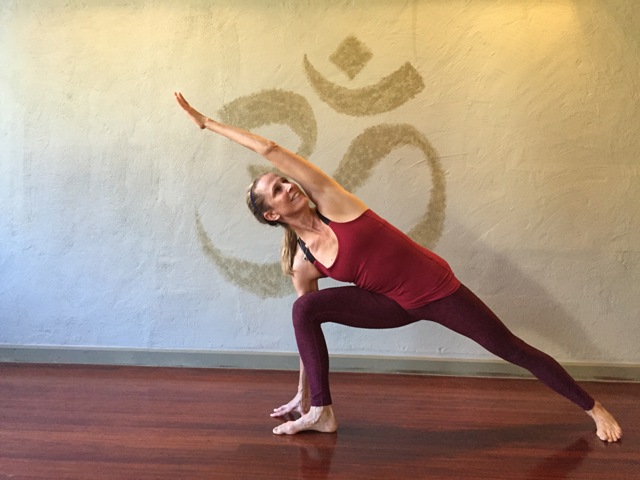Utthita Parsva Konasana or Extended Side Angle Pose
The Bhagavad Gita gives us two definitions of yoga: Yoga is skill in action (B.G. 2-50) and Yoga is equanimity of mind (B.G. 2-48).
One of the best ways to learn more about your yoga poses is by either practicing in front of a mirror, having someone take a picture of you in a pose, or looking at yourself on the screen in a zoom class. This is often very humbling. We are often not as advanced as we think we are! I know I have often been surprised by the fact that what I look like in my mind and how I look on screen are very different. Seeing yourself is a great way to learn and and develop skill. Awareness is always the first step in growth.
Side Angle Pose is a building block towards other advanced poses so it is important to work on and understand Parsva Konasana.
Take a picture of yourself in Side Angle pose from the front and from your head side. Then compare your pose to an example of a well done posture. Be wary of some of the poses you find online on Facebook or Instagram. While you may find some very correctly executed postures, there are many more not so well executed. Like these examples:
Here my front thigh is lower than horizontal and my back leg is collapsing.
Here I have collapsed my neck and shoulder on the lower side and I am not a straight line from my outer back foot up to my top fingers.
For skillfully executed postures, I recommend looking in Light on Yoga by BKS Iyengar. Or, for an online source click here to see a three-dimensional view of Parsva Konasana.
Mr. Iyengar demonstrating the alignment of Parsva Konasana
How does your pose measure up? Can you look at yourself critically but lovingly? Don’t beat yourself up by how bad you might think your pose looks. Instead, look at what you are doing that is good and work to build on that. Look at where you need to move to. Knowing where you are helps you move towards where you want to be. Remember the definitions of yoga refer to skillful action and equanimity of mind, not perfection in asana.
Sometimes students look at a pose and see certain things that they attach importance to, such as the hand on the floor in Side Angle Pose. While the hand on the floor is a goal, you have to first look at the skill of that action.
The full version of Side Angle Pose is with the front knee bent 90 degrees, the knee is over the ankle and the front thigh is parallel to the floor. The upper side of the body should be a straight line from the outer edge of the back foot up to the tips of the fingers of the top hand.
Side view
But, you also have to look at the pose from the front. The body should be very 2 dimensional from the front. That means that the outer buttock of the front leg should be in line with the outer knee, which is in line with the outer heel. The buttocks should not be winging out.
In this view, I have the outer buttock of my front leg in line with the outer knee and my chest is facing sideways. This is skillful action
In this view, you can see that my buttocks are winging out and my chest is facing slightly downward rather than shining out to the side. This usually happens when a student prioritizes getting the hand to the floor over the form of the pose.
If I didn’t have the flexibility to get my hand to the floor, I would be better off placing my hand on a block, or my elbow on my knee if I didn’t have a block, and turning my chest open and then gradually, over time, I would be able to lower my hand to the floor.
A beautiful, modified pose.
One interesting way to do Side Angle Pose is lying down on the floor. The floor will serve as a guide as to align your shoulders, buttocks and hips in the same plane. If you take classes with me you will often hear me say that there are only 12 yoga poses and they are done in different relationships to gravity. When you are doing Side Angle while standing, gravity helps you bend deeply into your front leg. When you do it lying down on the floor, gravity will help turn your chest open. Doing poses lying down on the floor can also show you what you do and don’t know about where to place your body.
Can we learn to be skillful in practice? Can I find equanimity in backing off from grasping for the full pose until I develop the skill to enter the pose gracefully?











